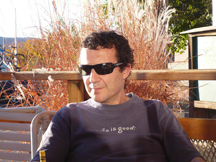Paul C. Bressloff

Professor of Mathematics
Brain and Behavior
e-mail: bressloff@math.utah.edu
B.A. 1981, Oxford University; Ph.D. 1988, King's College London
RESEARCH:
Theoretical neuroscience
My main research interests lie in the area of mathematical neuroscience. The particular focus of my work is to understand how the brain functions as a complex dynamical system at multiple spatial and temporal scales, both in healthy and diseased brains. From the biological perspective, this involves many different levels of description from the molecular basis of memory and learning at an individual synapse to the large-scale structure of cortex responsible for higher cognitive function. From the modeling perspective, the work draws upon a wide range of techniques in applied mathematics and theoretical physics including dynamical systems theory, differential equations, pattern formation and nonlinear wave theory, non-equilibrium statistical physics, biophysics and the theory of self-organizing systems.
Selected Publications:
Reviews
NEW! Paul C. Bressloff. Spatiotemporal Dynamics of Continuum Neural Fields J. Phys. A 45 (2012) 033001
P. C. Bressloff. Lectures in Mathematical Neuroscience In: Mathematical Biology, IAS/Park City Mathematical Series.(M. A. Lewis, M. A. J. Chaplain, J. P. Keener and P. K. Maini (eds) 14 293-398 (American Mathematical Society, 2009).
P. C. Bressloff. Pattern formation in visual cortex. Les Houches Lectures in Neurophysics (2005).
P. C. Bressloff and S. Coombes. Physics of the extended neuron. Int. J. Mod. Phys. B 11:2343-2393 (1997).
Selected papers (2001-)
MOLECULAR TRANSPORT IN NEURONS
P. C. Bressloff and J. Newby. Quasi-steady state analysis of motor-driven transport on a two--dimensional microtubular network. Phys. Rev. E 83 061139 (2011).
J. Newby and P. C. Bressloff. Local synaptic signalling enhances the stochastic transport of motor-driven cargo in neurons. Phys. Biol. 7 036004 (2010).
J. Newby and P. C. Bressloff. Directed intermittent search for a hidden target on a dendritic tree. Phys. Rev. E 80 021913 (2009).
P. C. Bressloff, B. A. Earnshaw and M. J. Ward. Diffusion of protein receptors on a cylindrical dendritic membrane with partially absorbing traps. SIAM J. Appl. Math. 68 1223-1246 (2008).
B. A. Earnshaw and P. C. Bressloff, A biophysical model of AMPA receptor trafficking and its regulation during LTP/LTD. J. Neurosci. 26 12362-12373 (2006).
P. C. Bressloff, A stochastic model of protein receptor trafficking prior to synaptogenesis Phys. Rev. E 74 031910 (2006).
STOCHASTIC NEURAL AND POPULATION DYNAMICS
Y-M Lai, J. Newby and P. C. Bressloff. Effects of demographic noise on the synchronization of metacommunities by a fluctuating
environment.Phys. Rev. Lett 107 118102 (2011).
P. C. Bressloff and Y-M Lai. Stochastic synchronization of neuronal populations with intrinsic and extrinsic noise. J. Math. Neurosci. 1 2 (2011).
P. C. Bressloff. Metastable states and quasicycles in a stochastic Wilson-Cowan model of neural population dynamics.Phys. Rev. E 82 051903 (2010).
P. C. Bressloff. Stochastic neural field theory and the system-size expansion. SIAM J. Appl. Math 70 1488-1521 (2009).
W. H. Nesse, C. A. DelNegro and P. C. Bressloff. Oscillation regularity in noise-driven excitable systems with multi-timescale adaptation. Phys. Rev. Lett. 101 088101 (2008).
ADAPTIVE NEURAL FIELDS AND BINOCULAR RIVALRY
P. C. Bressloff and M. A. Webber. Neural field model of binocular rivalry waves. J. Comput. Neurosci.In press (2012).
Z. P. Kilpatrick and P. C. Bressloff. Binocular rivalry in a competitive neural network with synaptic depression. SIAM J. Appl. Dyn. Syst. 9 1303-1347 (2010).
Z. P. Kilpatrick and P. C. Bressloff. Spatially structured oscillations in a 2D excitatory neuronal network with synaptic depression. J. Comput. Neurosci. 239 1048-1060 (2010).
Z. P. Kilpatrick and P. C. Bressloff. Stability of bumps in piecewise smooth neural fields with nonlinear adaptation. Physica D 239 1048-1060 (2010).
WAVES IN NEURAL MEDIA
Z. P. Kilpatrick, S. E. Folias and P. C. Bressloff. Traveling pulses and wave propagation failure in an inhomogeneous neural network. SIAM J. Appl. Dyn. Syst. 7 161-185 (2008).
S. E. Folias and P. C. Bressloff, Stimulus-locked waves and breathers in an excitatory neural network.SIAM J. Appl. Math 65:2067-2092 (2005).
S. E. Folias and P. C. Bressloff, Breathing pulses in an excitatory neural network. SIAM J. Appl. Dyn. Syst. 3,: 378-407(2004).
P. C. Bressloff and S. E. Folias, Front bifurcations in an excitatory neural network. SIAM J. Appl. Math. 65: 131-151 (2004).
P. C. Bressloff, Traveling fronts and wave propagation failure in an inhomogeneous neural network Physica D 155 :83-100 (2001).
MATHEMATICAL MODELS OF PRIMARY VISUAL CORTEX
L. Schwabe, K. Obermayer, A. Angelucci and P. C. Bressloff. The role of feedback in shaping the extra-classical receptive field of cortical neurons:
a recurrent network model J. Neurosci. 26 9117-9129 (2006).
P. C. Bressloff, Spontaneous symmetry breaking in self-organizing neural fields. Biol. Cybern. 93: 256-274 (2005).
P. C. Bressloff, Spatially periodic modulation of cortical patterns by long-range horizontal connections. Physica D 185:131-157 (2003).
P. C. Bressloff and J. D. Cowan, Spherical model of orientation and spatial frequency tuning in a cortical hypercolumn. Phil. Trans. Roy. Soc. B 358:1643-1667 (2003).
P. C. Bressloff and J. D. Cowan, An amplitude equation approach to contextual effects in primary visual cortex. Neural Comput. 14 :493-525 (2002).
P. C. Bressloff, J. D. Cowan, M. Golubitsky, P. J. Thomas and M. Wiener, Geometric visual hallucinations, Euclidean symmetry and the functional architecture of striate cortex Phil. Trans. Roy. Soc. B 40 :299-330 (2001).
Conferences and Workshops
Search and Exploration, Cargese Research Institute, April 25-30, 2011
SIAM Conference on Applications of Dynamical Systems, Snowbird, May 22 - 26, 2011
Spatio-Temporal Evolution Equations and Neural Fields, CIRM, Marseilles, October 24-28, 2011
Stochastic Modelling in Biological Systems, Oxford, March 18-23, 2012
